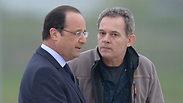
'Assad used chemical weapons, despite agreement'
French PM claims they have information that the Syrian regime is still using chemicals weapons, despite August deal to hand in chemical stockpile.
The news came amid reports of additional chemical attack in Syria.
Damascus agreed to give up its chemical arsenal after Washington threatened military action following the death of hundreds of Syrians in a sarin gas attack on the outskirts of Damascus during Syria's civil war last August. But Damascus is several weeks behind schedule in handing over its lethal toxins, Reuters reported.
“We have a few elements of information but I do not have the proof," Hollande said in a radio interview after he was asked about reports that Assad was currently using chemical weapons. “What I do know is what we have seen from this regime is the horrific methods it is capable of using and the rejection of any political transition,” he told the Europe 1 radio station.
Related stories:
- Syrian opposition accuses Assad's forces of new poison gas attack
- Report: Dozens hurt in chemical weapons attack in Homs
French Foreign Minister Laurent Fabius told the same radio station there were indications, which have yet to be verified, that there have been recent chemical attacks. He said they were much less significant than those in Damascus a few months ago but very deadly, and had taken place in the northwest of the country, near the Lebanese border.
A French source close to the matter told AFP that the reports had come from different sources, including the Syrian opposition. There are conflicting accounts about one attack that happened in the town of Kafr Zita in the central Hama province earlier in April, with both the government and the opposition accusing each other of being responsible.
Activists in the area accused the regime of using chlorine gas, saying it caused more than 100 cases of suffocation. Videos circulated by opposition activists on YouTube showed men and children in a field hospital coughing and showing symptoms of suffocation. But state television blamed the Al-Qaeda-affiliated Al-Nusra Front, a key force in Syria's three-year armed revolt, for the attack.
Under the terms of the US-Russia brokered deal reached last year, Syria has until the end of June to destroy its chemical weapon stockpile if it wants to ward off the threat of US air strikes. The agreement was reached after a deadly chemical attack outside Damascus last August that the West blamed on Assad’s regime.
Syria has submitted a "more specific" list of its chemical weapons to the global regulator overseeing the destruction of its stockpile after discrepancies were reported by inspectors on the ground, officials said.
A diplomat said questions had been raised by member states at the Organisation for the Prohibition of Chemical Weapons (OPCW) about the details of its chemical arsenal submitted by President Bashar al-Assad's government last year.
The officials said the original list had been based on estimates, not exact amounts of toxic agents found in storage and production facilities across Syria.
The joint UN/OPCW mission in Syria found "discrepancies between what they found, and what was on the original declaration", one diplomat told Reuters.
OPCW spokesman Michael Luhan confirmed a revised list had been submitted. "For some of the stockpile, ranges of quantities had been provided. Now they are being replaced with specific amounts," he said.
The exact amounts came to light after inspectors visited the sites, took inventory, and packaged the chemicals for transport to the port town of Latakia, he said. Official could not provide specific details about the discrepancies.
Syria initially reported to the OPCW having roughly 1,300 metric tons of toxic chemicals, including precursors for poison gas and nerve agents. Luhan said no new chemicals were added in the revised list.
As part of a deal reached with the United States and Russia last year, the Assad government agreed to abandon the weapons of mass destruction and destroy all chemicals in its possession by June 30.
Syria did not make public the exact list of chemicals, but officials have said it includes more than 500 metric tons of highly toxic chemical weapons, such as sulfur mustard and precursors for the poisonous gas sarin, as well as more than 700 metric tons of bulk industrial chemicals.
They are being loaded onto Norwegian and Danish ships in the Syrian port town of Latakia as part of a multi-million-dollar operation involving at least 10 countries.
The chemical weapons will be neutralized at sea on a specially-equipped U.S. ship, the MV Cape Ray, while the bulk chemicals will be sent to commercial waste facilities in Finland, Britain and Germany.
But Syria has fallen several weeks behind schedule in handing over the chemicals, having shipped out nearly two thirds of the stockpile for destruction abroad.
After missing several deadlines, Syria submitted a revised plan to the OPCW, saying it would hand everything over by April 27, or within 10 days.
An official at the OPCW, who spoke on condition of anonymity, confirmed a new list had been submitted, but said it was part of a routine reporting process.
"Sometimes information is not complete, or not in a format we require. It's not extraordinary," the official said. "But what they have submitted needs to be seen to come to any conclusions and I better not speculate about what's in there."
AFP and Reuters contributed to this report











